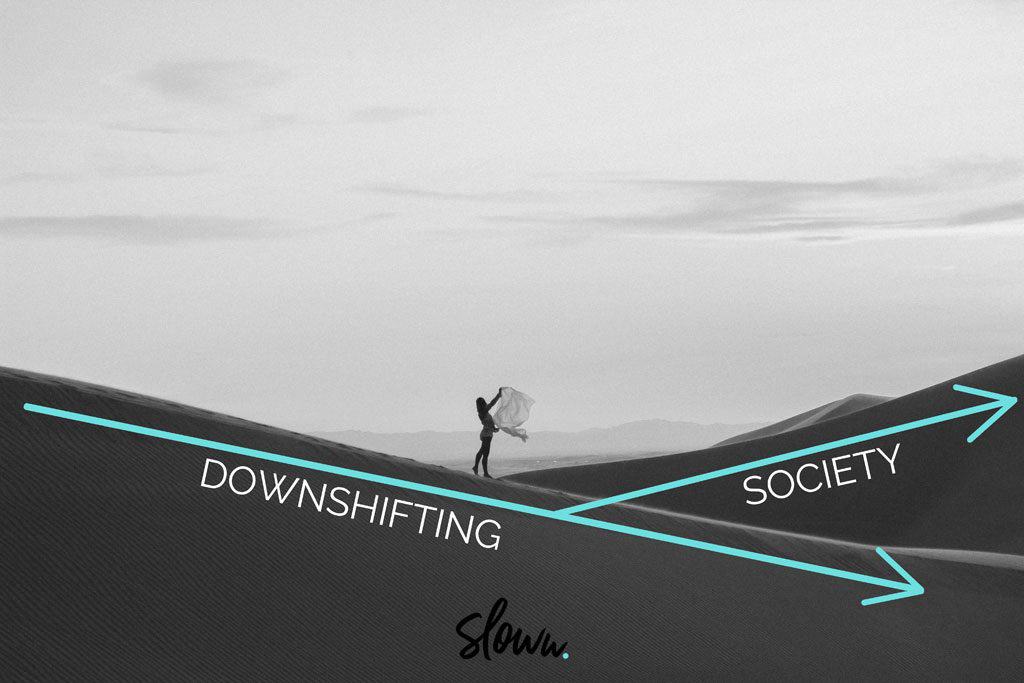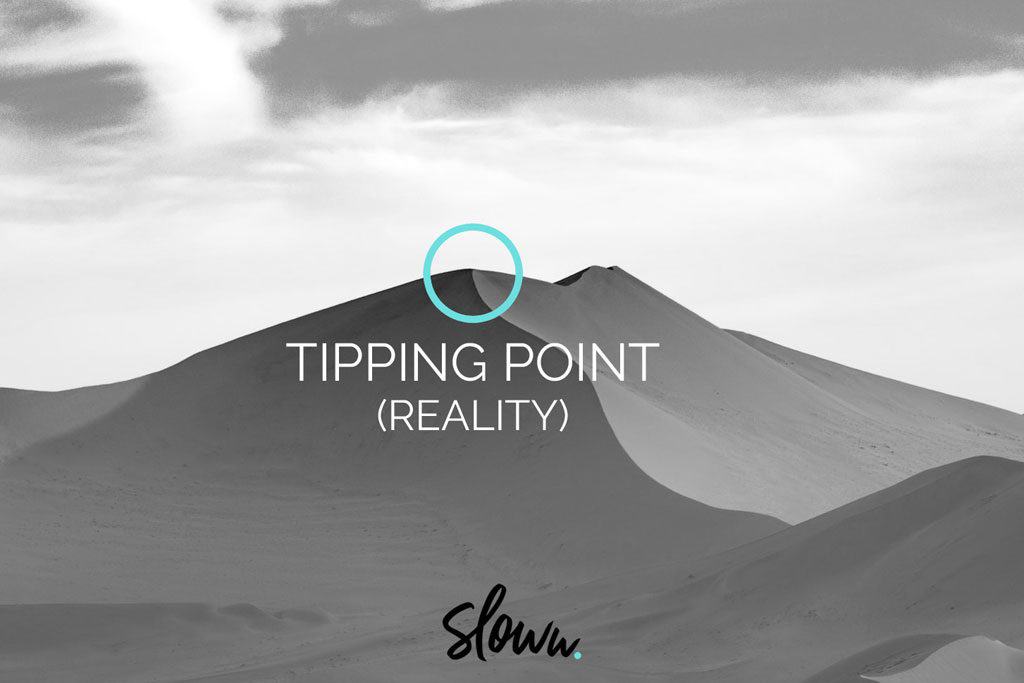I’ve been driving manual transmission cars my entire life, but I had only heard the terms “downshift” and “downshifting” related to gears.
A couple years ago, I was delighted to discover downshifting can apply to our lifestyles:
“Change a financially rewarding but stressful career or lifestyle for a less pressured and less highly paid but more fulfilling one.”
Since I just quit my corporate 9-to-5 job, now is the perfect time to revisit downshifting. The definition above is very fitting; the only difference is “less highly paid” means “nada” for me right now.
If you’re interested in simple living but don’t know where to begin, downshifting is a great place to start. If any of your friends or family express interest in slow or simple living, this is a great post to share with them to get them started on their journey.

What is Downshifting and who are Downshifters?
I did a bunch of research on downshifting so you can just read the highlights in this post. Here are the best definitions and descriptions of downshifting I came across:
- “Downshifting means working towards simple living by making conscious choices to leave materialism behind and move on to a more sustainable lifestyle.” — Choosing Voluntary Simplicity(1)
- “The act of reducing one’s standard of living for an improved quality of life.” — Investopedia(2)
- “Downshifters are people who adopt long-term voluntary simplicity in their life. They accept less money through fewer hours worked in order to have time for the important things in life. Downshifters also place emphasis on consuming less in order to reduce their ecological footprint … Basically downshifters seek a life filled with more passion and purpose, meaning, fulfillment and happiness. A life to look back on with no regrets. Downshifters want to slow down at work in order to ‘upshift’ in others areas of their lives. For most people the change to a slow life through downshifting comes after a long quest for true happiness and fulfillment.” — Slow Movement(3)
- “A social behavior or trend in which individuals live simpler lives to escape from what critics call the rat race. The long term effect of down shifting can include an escape from what has been described as economic materialism as well as reduce the ‘stress and psychological expense that may accompany economic materialism’ … Down-shifters are people that adopt long term voluntary simplicity in their lives. A few of the main practices of down-shifters includes accepting less money for fewer hours worked while placing an emphasis on consuming less in order to reduce their ecological footprint … The personal goals of downshifting are simple: To reach a holistic self-understanding and satisfying meaning in life.” — Wikipedia(4)
- “… a downshifter, someone who has decided that in one’s career, more isn’t always better. While there have always been corporate dropouts who hated the so-called rat race, downshifters just want a more balanced life. They may opt out of corporate life, or just simplify their lives by taking less stressful and time-consuming jobs, offsetting the income decline with more frugal lifestyles.” — Wall Street Journal(5)
- “At the core of the movement are values. People are valuing money and possessions less, and valuing time, health and peace of mind more. Regardless of the degree to which people scale back at work, pare down their lifestyles or relax the overall pace of their lives, downshifting is about people separating what they want from what they need to be happy … Downshifting refers to people shifting out of what you might term a single focus—a corporate focus—and into a more balanced-life focus.” — Workforce(6)
5 Myths & Realities of Downshifting
The Wall Street Journal and Workforce descriptions and articles above are from over 20 years ago, but they could have been written yesterday. They are more relevant now than ever before. In 2003, The Guardian reported, “4 out of 10 people aged under 35 are planning to downshift from stressful jobs to a slower pace of life.”(7)
1. Downshifting and technology:
Also, keep in mind, those articles were written before Facebook and before the iPhone — a time that seems like a lifetime ago. It seems like society has only exponentially increased its speed since then. In 2018, we are now desperately in need of downshifting to have a more intentional pace in our lives. While downshifting can mean taking a step back to reevaluate your life, it doesn’t necessarily mean going back to a time before technology. I personally believe we should use technology as a tool to make our lives better — instead of technology using us. But, new inventions and innovations can also unintentionally create new problems and challenges. Technology addiction is a real thing today; digital minimalism and digital declutter are growing trends.
2. Downshifting is a choice:
Downshifting — like voluntary simplicity — is all about choice.
3. Downshifting isn’t one-size-fits-all:
Everyone has a different motivation (or motivations) to downshift and start their simple living journey. There are people who want to quit the corporate rat race (escape the “work-and-spend cycle”), and there are people who simply want to work less or find a similar but less stressful job. Others do it to spend more time with family, children, and friends. And, for those sustainably-minded, some do it to lower their ecological footprint.
4. There are different types of downshifting:
For instance, here’s my personal version right now: Consumption Downshifting + Lifestyle Downshifting + Career Downshifting.
- Consumption Downshifting: I started downshifting my consumption in late 2015. I’ve made huge strides in things like eating out and clothing. But, the big purchases like house and cars are still things my wife and I are working on (currently guilty of lifestyle inflation) — hopefully we’ll have some big (good) news to share on those in the coming months.
- Lifestyle Downshifting: I’ve been attempting to adopt a slow living lifestyle outside of work since late 2015 as well. Unfortunately, there was only so much I could do outside of my 60/70/80-hour workweeks.
- Career Downshifting: Quitting my 9-to-5 job last week has finally allowed for this one to be combined with lifestyle downshifting. For the indefinite future, I own 100% of my time — aiming to work-to-live instead of live-to-work.
5. Downshifting doesn’t happen overnight:
That’s why it’s called downshifting! It’s a gradual process. This is an important one. So important, that I felt compelled to illustrate the point based on my own personal experience. The image below shows the belief I (like many others I’m sure) thought life was going to be like after I decided that I was going to adopt slow and simple living. I thought the tipping point was going to be like flipping a switch. One day life is crazy busy and complicated, the next it’s slow and simple. That’s how it works, right?

Instead, the tipping point isn’t technically a point as much as a plateau. It takes a lot of conscious and intentional effort to make big consumption, lifestyle, or career changes. If you’ve been speeding up and consuming more your entire life, it’s not going to simply change overnight to slowing down and consuming less. So, the image below represents my reality now looking back on it.
The tipping point shows where a decision to live a life of slower and less was made. However, it’s not always easy. After the tipping point, you’ll notice that things start to gradually decrease but then revert back to increasing. Relapsing into old behavior isn’t uncommon. After all, the best predictor of future behavior is past behavior. But, I finally feel like I’ve just crossed over the second peak in that image and am now on a true path of deceleration into slower and simpler living.

5 Ways to Begin Downshifting into Simple Living
First, bookmark and routinely revisit the downshifting definitions, descriptions, myths, and realities above.
1. Start small:
Maybe just start with minimalism and use that as momentum. Or, get started with slow living:
- Slow Living 101: What is Slow Living?
- Slow Living 201: A Deep Dive into Slow Living & The Slow Movement
- Slow Living 301: How to Start a Slow Living Lifestyle
2. Remember that this is a choice:
Choose your own adventure. Think about what motivates you and what type or types of downshifting you think are right for your life right now.
3. Define your purpose:
Take inspiration from Gandhi or the people in the Blue Zones who live simply beyond the age of 100. Maybe try the method of asking yourself “Why?” five times.
4. Track and analyze your finances:
Think about how and where you can and will fund your consumption, lifestyle, or career changes. I recommend checking out the FIRE community (Financial Independence Retire Early). Think about money as freedom instead of something that’s spent on things or experiences.
5. Join the conversation:
There are some great slow and simple living forums and communities online.
Bonus: And remember, it’s a journey
In some cases, it will take a lifetime. The initial image of this post is the same as the last one below. Society will always try to lure you back — I describe this as the “elasticity of society.” It’s very easy to snap back into society and get back on the on-ramp to mainstream society. Stay strong!
- “By redefining life satisfaction in non-material terms, downshifters assume an alternative lifestyle but continue to coexist in a society and political system preoccupied with the economy.” — Wikipedia(4)
Good luck! I’m with you on this journey to less stressful, more fulfilling, lighter living.
Have you tried downshifting? I would love to hear your personal story in the comments.
Slow Living Resources
- Slow Living Life Hacks
- Slow Living Challenges
- Slow Living Online Forums & Communities
- Slow Living Quotes
- Slow Living Book Summaries
- Slow Living Videos
You can follow Sloww via email using the form field below this post or on social media: Twitter | Facebook | Instagram | Pinterest
Footnotes:
- http://www.choosingvoluntarysimplicity.com/downshifting-to-a-simpler-life/
- https://www.investopedia.com/terms/d/downshifting.asp
- http://www.slowmovement.com/downshifting.php
- https://en.wikipedia.org/wiki/Downshifting_(lifestyle)
- https://www.wsj.com/articles/SB88524917030426000
- http://www.workforce.com/1996/03/01/downshifters-workers-are-scaling-back-are-you-ready/
- https://www.theguardian.com/money/2003/oct/15/changingjobs




